Oradour-sur-Glane, France – July, 2011
Rob and I had never heard of the little village of Oradour-sur-Glane until we visited the site during a tour from Paris to the south of France. By the time we left that afternoon, the tragic story of the town and the massacre of its people were seared indelibly into our memory.
On June 10, 1944, Nazi soldiers invaded the quiet town of Oradour-sur-Glane in the Haute-Vienne region of France. The soldiers were seeking revenge for the capture of a high ranking SS officer.
All villagers, from a baby of one-week-old to those in their nineties, and a group of six who had the misfortune to be bicycling through Oradour that morning, were ordered to report to the village square – “to have their papers checked.” A few suspicious souls hid in their homes and escaped into nearby woods. Most, however, complied. Once in the square, the citizens were accused of hiding weapons and told they would be held while soldiers searched their houses. Men were herded into barns around town. Women and children were taken into the church.
Upon a signal from their commanders, the soldiers first shot the men in the legs so they could not escape, then doused them in fuel and lit the barns on fire. The church interior was also set ablaze. Women who tried to escape through the tiny windows were shot. The entire village was then torched and reduced to rubble.
Six hundred forty-two people were slaughtered that day. Twenty-six survived: twenty who had slipped away when the soldiers arrived, five men who crawled from the back of a barn, and one woman who was shot as she jumped from the narrow window at the back of the church but succeeded in crawling into a garden to hide.
Following the war, France decided to maintain the village just as the Nazis left it, as a testament to the atrocities of war and as a memorial to the “Martyrs of Oradour.”
Rob and I read the history of this incident in the museum that stands just outside the ruined village, then walked up the path to see the preserved town.
Scorched and crumbling walls of stone buildings stand as evidence to the events of that day. Plaques on the walls still advertise former businesses – the dentist’s office, the garage, the post office.


My husband and I walked silently through the town’s ruined streets, stopping here and there to view remnants of daily life: a burned out car, the bent and rusted frame of a bicycle still propped against a wall, an iron bed frame, a sewing machine.
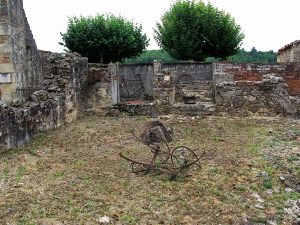
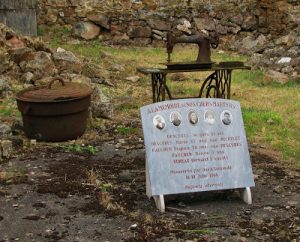
Most horrible of all were the skeletal remains of a baby carriage in front of the bullet-scarred church altar.
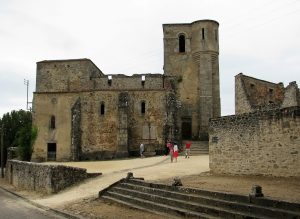
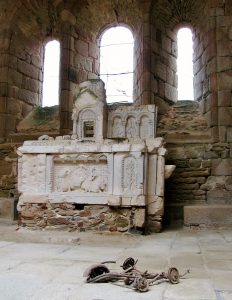
As we continued through the streets, the gloomy grey skies contributed to our overwhelming sadness. When we reached the cemetery on the little hill at the back of the town, where many of the gravestones contain photographs of both adults and tiny children who were killed that day, I could no longer contain my tears.
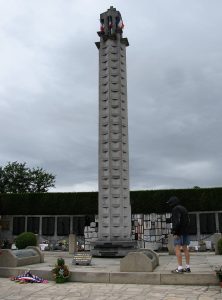
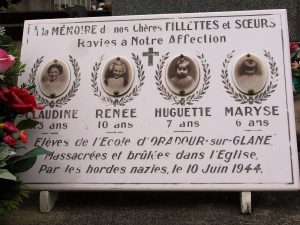
The bus ride to our next destination was silent.
I wondered as we rode why Oradour-sur-Glane is unfamiliar to so many of us outside of France. Perhaps because it was a small incident compared to the death of millions. Perhaps because it involved no major battles or well-known historic figures. For me, that makes it even more appalling…a peaceful village doing its best to maintain normal life amid the chaos of war, decimated in the space of a few hours.
When I told the story of this tragic village, a friend commented, “We go on vacation to relax and have a good time. We don’t go on trips to be depressed. Why should we visit sites like this?”
Why, indeed? The large sign at the entrance to the ruins of Oradour-sur-Glane says “Souviens-toi. Remember.” This echoes another saying associated with the Holocaust, “Forgive, but never forget.” But the reality is, we do forget. Perhaps some knowledge is so unspeakable, we choose to put it into a hidden compartment of our minds to preserve our own sanity. It’s easy to do. By that evening, our tour group was laughing again under the sunset’s glow on the yellow stone buildings of Sarlat.
This is normal, even healthy. But truly meaningful travel – travel that encompasses the full spectrum of history and human experience – is more than an excuse to see famous sights, to enjoy new foods, to “relax and have a good time.” The privilege of travel perhaps brings with it a special responsibility. When our travels take us to the sites of the darker events of the past, we can return home with the stories that help the world remember.
Thanks for sharing the story of this place. When we let ourselves forget, history repeats.
Thanks, Theresa. Sadly, history seems to repeat even when we do remember, but I’m sure that learning about the past does make a difference for at least many of us.
Thanks for sharing a chilling story with me. I feel like I keep meeting up with the horrors of our past as I have been traveling around. Unfortunately, it is not reassuring that such depredations occur on every shore.
You’re right, Kim, and with your travels in the American southwest, you are probably bumping into many of them. We have a pretty disgraceful history regarding the Native Americans. Hopefully, we have learned from our own history.
I’m so glad you wrote this piece, Joan. Remembering is so important, and for those who can’t/don’t travel this is a wonderful way of bringing history to their doorstep. This is beautifully written.
Thank you so much, Mary. This visit affected me more than almost anything in our travels. Walking through that ruined village was immensely sad, but it IS important to remember.
What a great ending and so very true: “When our travels take us to the sites of the darker events of the past, we can return home with the stories that help the world remember.”
Thank you. I think travel is so important in gaining a wider view of the world and the whole range of human experiences.
Yes, it’s easy to forget, just as we in this country tend to forget how the indigenous peoples of the Americas were slaughtered by European settlers, and how this country was built on the backs of slave labor. Who wants to remember that the history of one’s country includes chapters like that? And it’s difficult to remember that the Nazis were human beings, too, not born but made into monsters. I have to keep coming back to the idea that each one of us must educate ourselves and then continue to decide who we want to be in the face of the brutality behind – and around – us. We must also remember, and contribute to, and be the good, the generous, the kind, the open-hearted and open-minded citizens. Because that isn’t the only path forward; just the only path worth walking.
Thank you Joan for sharing your experience at this tragic site. There so much more to travel than doing a continuous happy dance. This is such a sad place, but a good site to remember the awful results of war. It reminded me of a grave I spotted in a Canadian war cemetery we visited in Abruzzo several years ago. Attached to the headstone of a 20-year-old casualty was a picture of his fiance. It was a sight that moved me to tears. I thought about how lucky I was to be alive and to have been married for many years with a daughter and two grandchildren. Up to that point I had been ignorant of how many English, Canadians, and Australians had fought up the eastern side of the Italian boot during WW11.
You have quite an impressive blog site.
Aw, this was a really good post. Spending some time and actual effort to make a very
good article… but what can I say… I hesitate a lot
and never seem to get anything done.
my blog techniques Seo